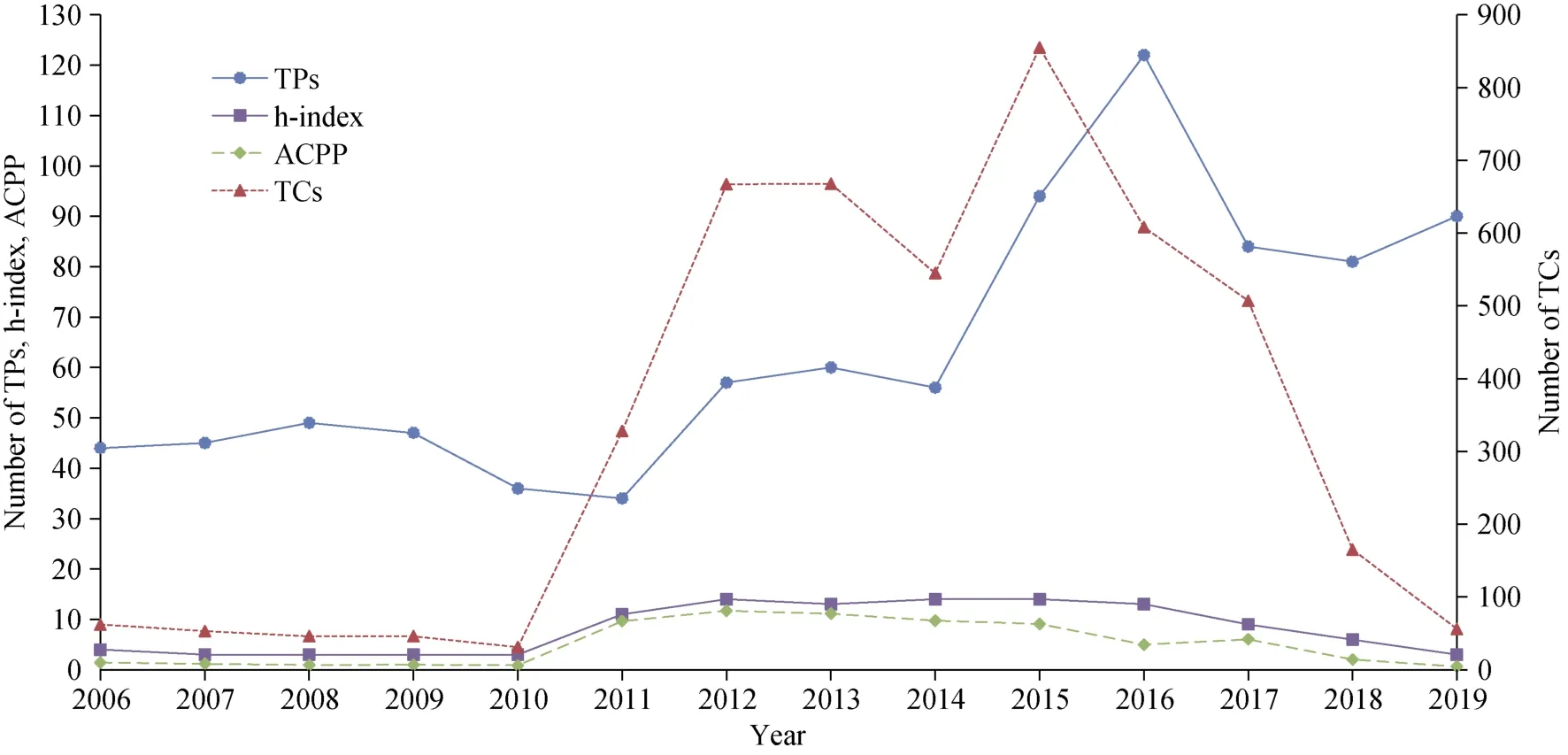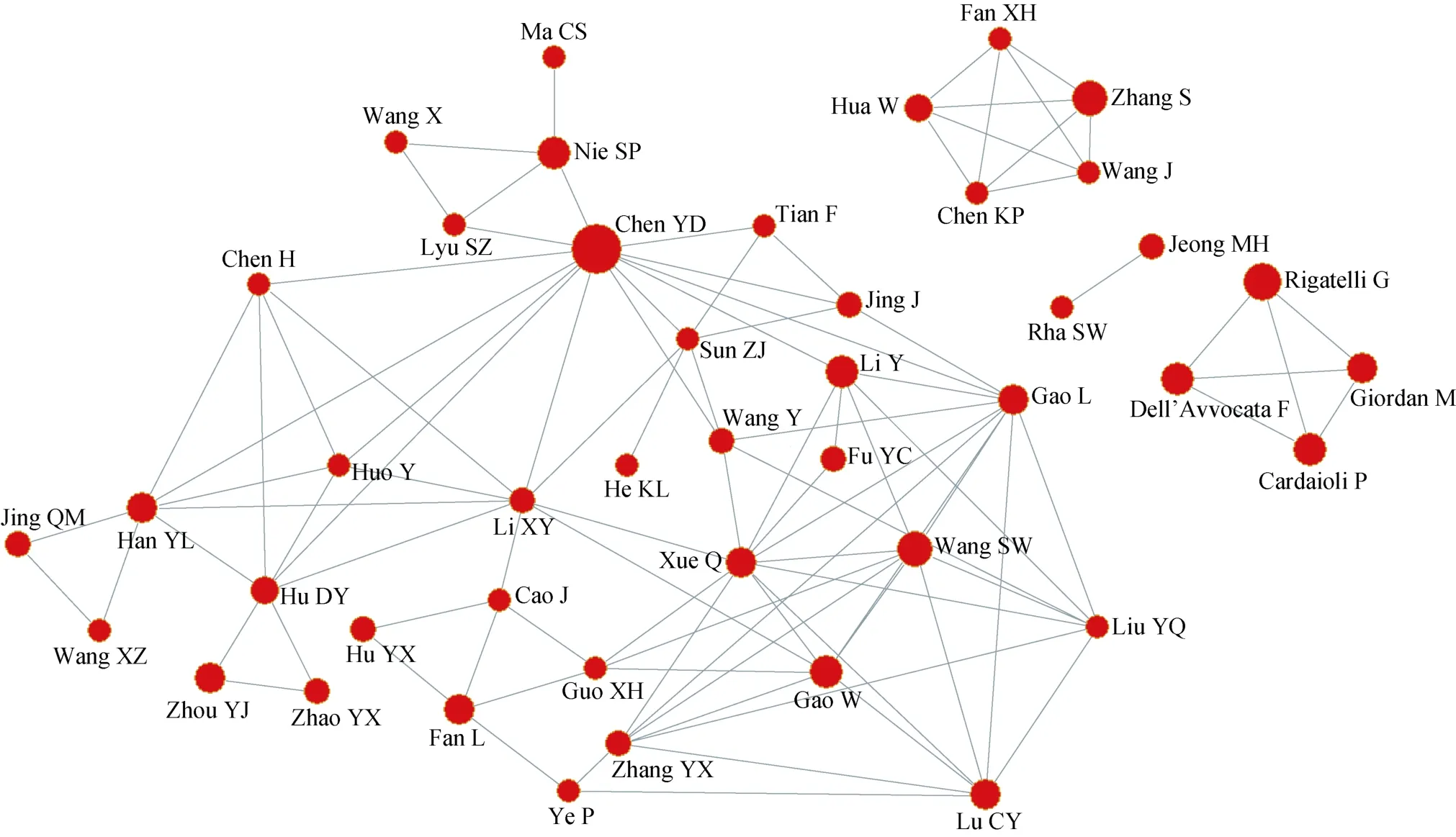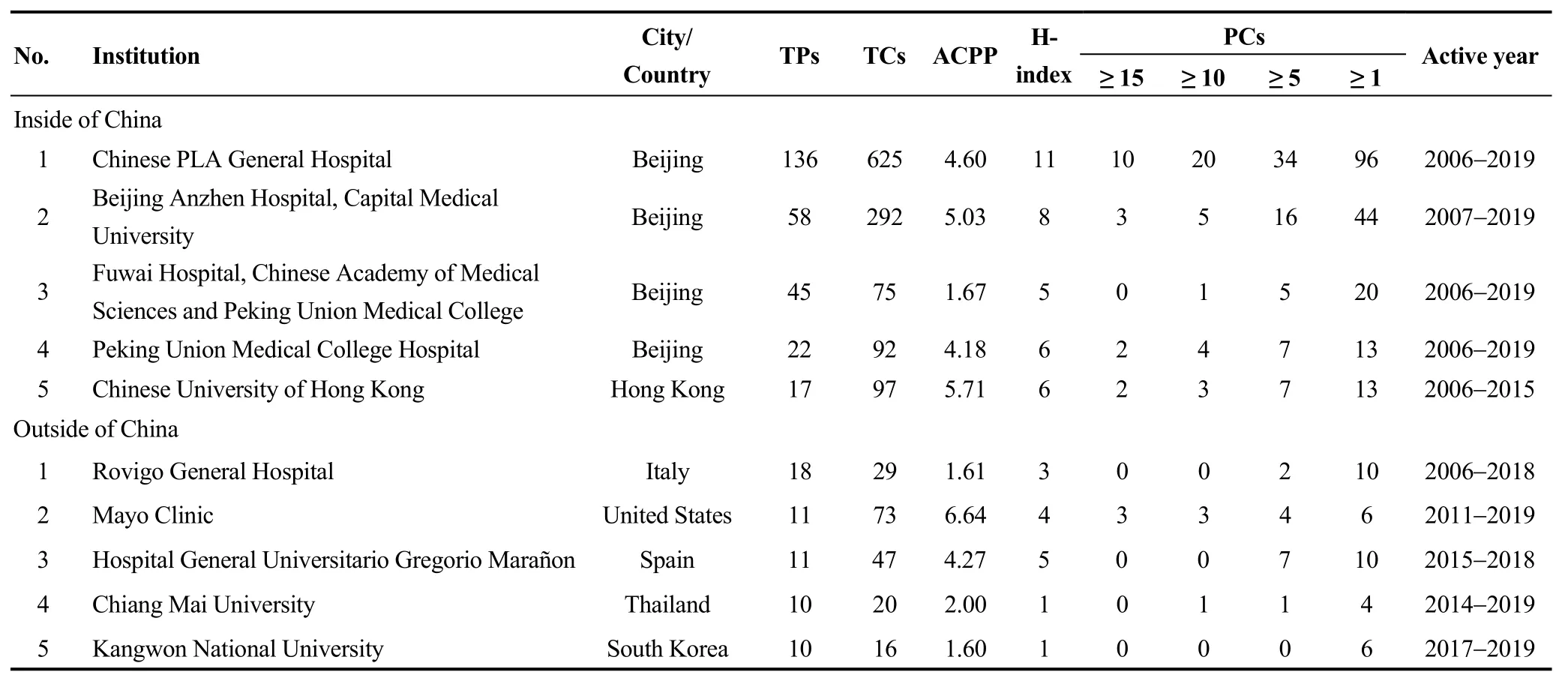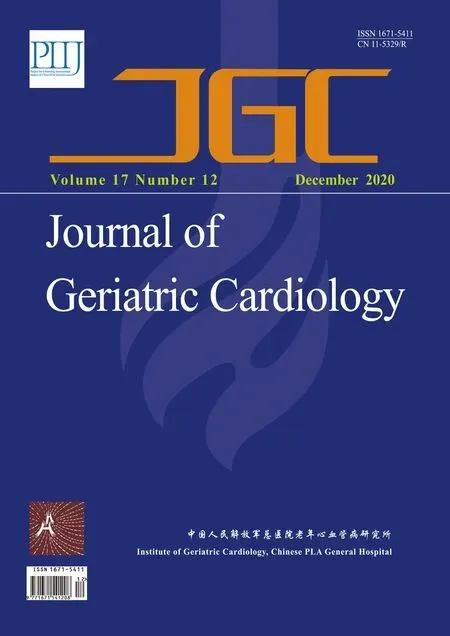Advances in Journal of Geriatric Cardiology over the course of a decade
Qiang WU, Lai-Fu LI, Yun-Dai CHEN
1Institute of Geriatric Cardiology, Chinese PLA General Hospital, Beijing, China
2Department of Cardiology, Chinese PLA General Hospital, Beijing, China
3Journal of Geriatric Cardiology Editorial Office, Chinese PLA General Hospital, Beijing, China
Keywords: Bibliometrics; Citation analysis; Journal of Geriatric Cardiology; Peer review; Research hotspots*The authors contributed equally to this manuscript.#Correspondence to: cyundai@vip.163.com
TheJournal of Geriatric Cardiology(JGC, ISSN 1671-5141/CN 11-5329/R) is a monthly, open-access, international, and peer-reviewed journal sponsored and published by the Institute of Geriatric Cardiology affiliated with Chinese PLA General Hospital.It was created in 2004 by Prof.Shi-Wen WANG, and as the current editor-in-chief,Prof.Yun-Dai CHEN has been involved in JGC for eight years and has achieved impressive advancements.In particular, JGC was indexed in the Science Citation Index Expand (SCIE) of the Web of Science in 2011 and PubMed Central in 2012.JGC focuses on both basic research and clinical practice regarding the diagnosis, prevention and treatment of cardiovascular disease in elderly people, especially those with concomitant diseases of other major organsystems.According to the 2019 Journal Citation Reports(InCites, Clarivate Analytics), the SCI impact factor of JGC has increased from 1.763 to 2.491 in 2019.JGC ranks 30/51 and 66/138 in the fields of Geriatrics & Gerontology and Cardiac & Cardiovascular Systems, respectively.
Analysing the characteristics of JGC will enable the journal to better serve researchers and inform the long-term development trajectory of the journal.This article reports a bibliometric analysis of JGC (citation analysis), which is an effective research methodology that is often used to assess the characteristics and impacts of researchers, institutions,countries or journals and is the gold standard for measuring these impacts.[1]Data collection was performed through December 2019 in the Scopus database, which is currently the database with the most articles published in JGC according to searches in SCIE, PubMed Central, EMBASE,Google Scholar, Scopus,etc.This article presents a brief review of the characteristics of JGC based on the following four themes:
1.Publication and citation structure
2.Influential publications
3.Research hotspots in the journal
4.Major research collaborations among teams, institutions and countries
1 Publication and citation structure
As of December 2019, considering only articles, reviews,conference papers, and short surveys, JGC had published 899 manuscripts, the journal had 4,637 citations, and the number of citations per paper was 5.16.The h-index was 27.
The annual changes in the number of total publications(TPs), number of total citations (TCs), average number of citations per publication (ACPP) and h-index[2]are shown in Figure 1.Before 2012, the TPs, with several exceptions,ranged between 34 and 44 manuscripts per year.From 2012 to 2016, the number of publications steadily increased to an average of 77.8 manuscripts per year.In 2019, the number of manuscripts was twice that in 2006.
The trend in annual TCs in JGC first increased and then decreased.The TCs increased from 62 in 2006 to 855 in 2015 but then decreased to 56 in 2019.As the JGC was not indexed in SCIE before 2010, the TCs were relatively low.The low TCs of articles published in JGC in recent years may be attributed to the “delayed effect”, as there has not been sufficient time for the accurate determination of the citation value of recent publications and they have therefore not yet achieved their highest citation potential.The overall trend in ACPP in JGC is similar to the trend in TCs.
The annual citation structure is presented in Table 1.The highest level of the h-index was distributed between 2011 and 2016.The relatively lower level of the h-index before 2011 and after 2016 may be attributed to the extent to which JGC is being used and recognized, the publishing cycle, the extent of circulation, and the innovativeness of the contentin JGC.Nonetheless, it is expected that the h-index of JGC will increase in the coming years.The ACPP in JGC showed a generally increasing trend.In addition, Table 1 shows the publication citations (PCs) in JGC.

Figure 1.Annual changes in the TPs, h-index, ACPP and TCs in JGC.ACPP: average citations per publication; TCs: total citations;TPs: total publications.

Table 1.Annual citation structure of JGC.
2 Influential publications
Table 2 summarizes the ten most-cited publications in JGC according to Scopus.The ten most-cited publications were mostly published between 2012 and 2017.In addition,most of them were from China, and the most common types of publications were reviews and articles.Notably, the review from the National Center for Cardiovascular Diseases published in 2017, entitled “China cardiovascular diseases report 2015: a summary”,[3]has the highest average number of citations per year among all publications, and it is also the second most-cited publication.These ten most-cited publications, which were published by authors from Australia,Italy, the United Kingdom, France, the United States, Canada,Switzerland,etc., have been noticed by and cited in the scientific community, indicating that JGC plays an important role in academic communication.

Table 2.The ten most-cited publications in JGC.
3 Research hotspots in the journal
Keywords, which represent the essential topics and critical terms in a publication, are reflections of the fundamental topic of a publication and the academic concepts presented by the author.[4]The co-occurrence of keywords, which is defined by the appearance of two keywords in the same publication, indicates that there is a relationship between those keywords.Keyword cluster analysis is a method of assessing the co-occurrence of keywords, enabling a more accurate representation of the research hotspots in a given field.Therefore, the research hotspots in JGC were identified by keyword cluster analysis, which was performed with VOSviewer software.
A total of 3,286 keywords were extracted from JGC, and the top-ten most representative 43 keywords, based on the frequency of occurrence, were analysed (Figure 2).Those keywords were divided into six clusters: (1) Cluster 1 focused on the complications, prognosis and revascularization strategy of acute coronary syndrome in the elderly population;[5–8](2) Cluster 2 focused on cardiovascular imaging and interventional therapy in elderly coronary artery disease patients;[9–13](3) Cluster 3 focused on aortic disease and frailty in the elderly population;[14–17](4) Cluster 4 focused on the risk factors for and imaging evaluation, prognosis and management of atrial fibrillation in elderly patients;[18–21](5) Cluster 5 focused on the analysis and management of risk factors in elderly cardiovascular disease patients;[22–25]and (6) Cluster 6 focused on the mechanism, evaluation and resynchronization therapy of congestive heart failure in the elderly population.[26–30]Among these topics, ‘percutaneous coronary intervention’, ‘acute myocardial infarction’, ‘aortic valve replacement’, ‘atrial fibrillation’, ‘cardiovascular disease’ and ‘heart failure’ will be research hotspots in the coming years in JGC.
4 Major research collaborations among teams,institutions and countries
Different evaluation indicators, such as research collaborations among teams, institutions and countries, are also important factors that objectively reflect the influence of the journal, which is very important to encouraging and promoting the development of the journal and understanding its intrinsic value.Figure 3 presents the co-author network in JGC, which was generated with Pajek software, based on the presence of at least two collaborations among the authors and a minimum threshold of six publications for each of them.As shown in Figure 3, there are four types of coauthor networks (multi-member research collaboration team,5-member research collaboration team, 4-member research collaboration team, and 2-member research collaboration team).The multi-member research collaboration team,which is composed of 33 authors and has 6 authors forming the core, represents the highest degree of cooperation in the entire co-author network.The six core authors (Wang SW,Chen YD, Han YL, Hu DY, Huo Y and Gao W) are all authoritative experts in the field of cardiovascular disease in China, and they come from different research institutions with relatively stable research partners and play important roles in a wide range of collaborations between different research institutions.

Figure 2.Co-occurrence of keywords (threshold of ten) in JGC.The size of the nodes is proportional to the number of appearances of keywords, and the distance between two nodes is inversely proportional to the number of co-occurrences of keywords.
Table 3 shows the ten most productive institutions, defined by having at least ten publications in JGC.To provide a better overview, we included some indicators associated with the most productive institutions, such as the TPs, TCs,ACPP, h-index, number of active years, and whether they have at least 15, 10, 5, or 1 PCs.The most productive countries are shown in Figure 4.In terms of the most productive institutions and the most productive countries, it is clear that China is the leader.In particular, the Chinese PLA General Hospital (China) is a leading Chinese institution in terms of TPs, TCs, publications with at least 1 PC, and h-index.Outside of China, the leading institutions are Rovigo General Hospital (Italy), the Mayo Clinic (the United States), Hospital General Universitario Gregorio Marañon (Spain),Chiang Mai University (Thailand), and Kangwon National University (South Korea).However, Beijing Anzhen Hospital, Capital Medical University (China), Fuwai Hospital,Chinese Academy of Medical Sciences and Peking Union Medical College (China), Peking Union Medical College Hospital (China), and the Chinese University of Hong Kong(China) all have more than 13 citations.
Although JGC is published in China, it has included manuscripts from 52 countries.In addition to China, the United States, Italy, South Korea and Spain are also leading contributors, accounting for 13.4%, 6.2%, 4.5% and 3.4% of the articles, respectively.As shown in Figure 4, the most productive countries are mainly distributed throughout Asia and Europe but are also located in North America, South America, Africa and so on.
In short, theJournal of Geriatric Cardiologyhas made encouraging achievements in the fields of basic and clinical research on cardiovascular disease in elderly individuals inrecent years.As the figures and tables in our article show,this progress is supported by reliable data.In the future, to better reflect the current status and promote the expansion of research on cardiovascular disease in the elderly population,we have adopted the following guiding principles for the long-term development of the journal: (1) strengthening the editorial board to promote academic cooperation and attract high-quality publications; (2) adopting international manuscript processing systems (such as ScholarOne™, Clarivate Analytics) to streamline the editorial and publication process and promote the exchange of academic information;(3) tracking research hotspots to invite manuscripts fromauthoritative experts; (4) funding editorial training to acquire the latest professional knowledge and skills; and (5) increasing publicity to expand the international influence of JGC.

Figure 3.Co-author network with ≥ 2 collaborations and ≥ 6 publications in JGC.

Table 3.Most productive institutions in JGC.

Figure 4.Most productive countries in JGC.
Acknowledgements
This study was supported by the Project for Excellence Action Plan of China STM Journals (C-074).All authors report that they have no conflicts of interest to disclose.
 Journal of Geriatric Cardiology2020年12期
Journal of Geriatric Cardiology2020年12期
- Journal of Geriatric Cardiology的其它文章
- Catheter ablation for atrial fibrillation is associated with reduced risk of mortality in the elderly: a prospective cohort study and propensity score analysis
- Effects of angiotensin-converting enzyme inhibitor and angiotensin II receptor blocker on one-year outcomes of patients with atrial fibrillation: insights from a multicenter registry study in China
- Parity and carotid atherosclerosis in elderly Chinese women
- Validation of methods for effective orifice area measurement of prosthetic valves by two-dimensional and Doppler echocardiography following transcatheter self-expanding aortic valve implantation
- Venous thromboembolism prophylaxis-prescribing patterns among elderly medical patients in a Saudi tertiary care center: success or failure?
- Can sacubitril/valsartan become the promising drug to delay the progression of chronic kidney disease?
